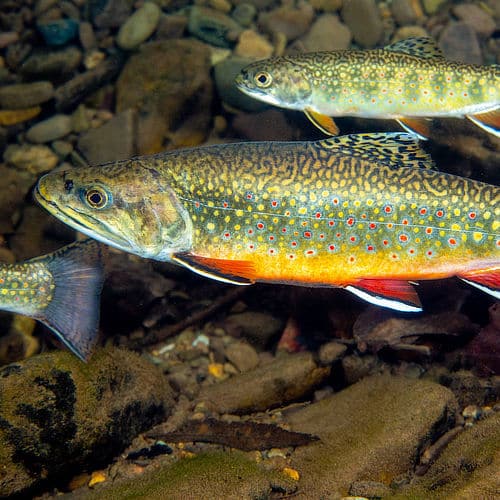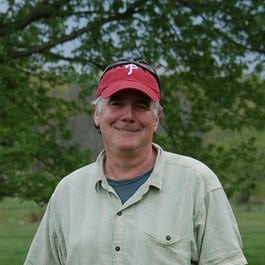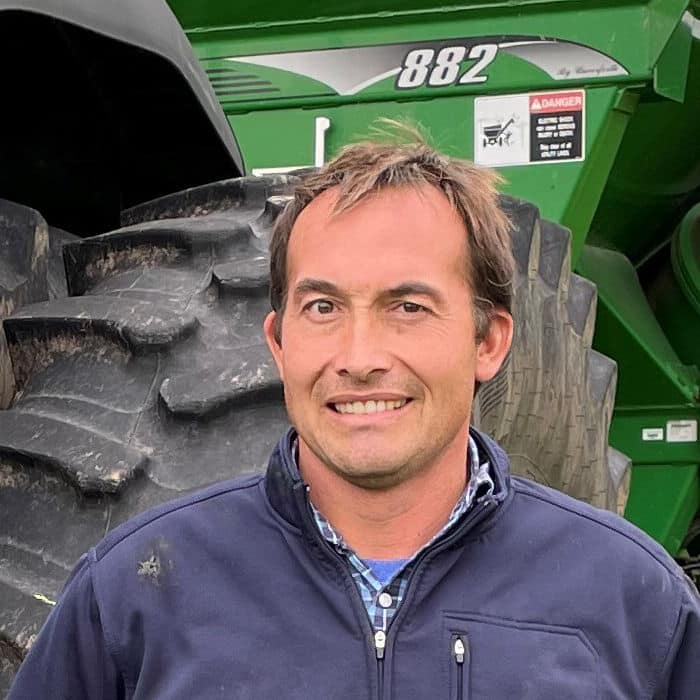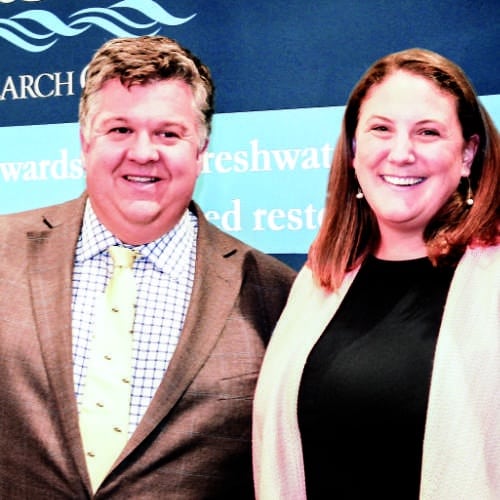In Pennsylvania, Property Owners and Farmers Are Transforming Their Lands to Restore a Stream’s Health and Its Native Fish

By David Wise
Might brook trout one day swim again in Red Clay Creek? If and when they do, it will be a sign that watershed restoration efforts are working in the stream that runs through southeastern Pennsylvania and northeastern Delaware.
The eastern brook trout (Salvelinus fontinalis) is the only trout native to streams of the eastern United States. It is widely regarded as one of the most visually striking American freshwater fish.
Sometimes called brookies, these fish once thrived in the streams of eastern forests and formerly occupied nearly 95% of Pennsylvania’s 1,313 watersheds, according to Eastern Brook Trout Joint Venture. Pre-Colonial forests provided the cool, clean water that brookies require.
But with the clearing of forests for timber and farming, and later mining, water quality suffered, and with it, brook trout. Today, just 1.2% of Pennsylvania’s watersheds have vibrant brookie populations. Almost 80% have few or none at all. Their decline reflects watersheds that suffer the stresses of pollution, climate change, and changes in land use.
But hope bubbles up. In the West Branch of Red Clay Creek, local residents are partnering with Stroud Water Research Center to restore the watershed to good health for all life that depends on clean water — from bugs to humans to brook trout.

Brookies in Decline
Eastern brook trout (Salvelinus fontinalis), sometimes called brookies, are the only trout native to streams of the eastern United States. These fish once thrived in the streams of eastern forests.
Then
Brookies once occupied nearly 95% of Pennsylvania’s 1,313 watersheds.
Now
Just 1.2% of PA’s watersheds have vibrant brookie populations. Almost 80% have few or none at all.
The loss of brookies is tied to human activities that degrade freshwater habitats.

Peter Welling, local resident
Like Peter Welling, most of the Stroud Center’s landowner partners along the West Branch of Red Clay Creek have planted a minimum of 100 feet of forest buffers on each side of the stream, which is the gold standard for protecting water quality.
Local residents like Peter Welling have embraced the challenge to reforest their stream. Welling is one of 12 landowners on the West Branch who have partnered with the Stroud Center to restore more than 100 acres of streamside forest. In total, the new trees and shrubs cover nearly half of the watershed’s deforested stream miles, and more plantings are in the works.
Welling grew up in the 18th century farmhouse at Scarlet Thicket Farm next to the West Branch and still lives there today. He says the property has been farmed since at least 1671 and that prior to European settlement, it was the winter campground of the Lenape people.
Welling says, “I’d often wondered what had happened to the stream I had fished, trapped, and waded 70 years ago. I’d wondered why thriving populations of aquatic reptiles, crayfish, sculpins, mussels, swarms of mayflies and caddisflies had all but vanished. Even the odd brook trout had disappeared. I wondered what had happened to the muskrats, pollinators, ground nesters, and upland game birds along the hedgerows and in the pasture grass.”
DID YOU KNOW?
Forested streams support
3 to 5x more
total aquatic life and remove
2 to 9x more
pollutants
In 2000 he fenced out livestock, reforested 35 acres along the creek corridor, and took some acres out of production to plant them with warm season grasses. Then, a few years ago, with guidance and support from the Stroud Center, he doubled the forest acres, planted an additional 10,000 deciduous trees, and created a plan to mitigate erosion and runoff from crop fields.
“Along the way, I chided and encouraged my upstream neighbors to do the same thing, and in partnership with Stroud, they are,” says Welling.
His property, and much of the agricultural land along the West Branch, is farmed by Jamie Hicks. As the owner of a crop-farming business, he leases more than 5,000 acres in Chester County and the surrounding region. He also integrates stewardship into every facet of his farming operation and helps his landowners improve their land and water in the process.
Recently, Hicks treated more than 600 acres of land with next-level actions for soil health and nutrient management on the West Branch. Cover crops and no-till farming are among them and have proven benefits for stream health. Soils managed with long-term no-till and cover crops can absorb rainfall at two to four times the rate of conventionally farmed soils, thereby reducing how much soil, manure, nutrients, agricultural chemicals, and pathogens reach streams.
When asked what motivates his tireless efforts, he says, “I want to be the best I can be at what I do. I want to surround myself with experts and use resources available to me to protect and improve the soil I’m using in my lifetime — making it better than when I started farming with hopes to pass it on to the next generation.”

Jamie Hicks, local farmer
Jamie Hicks, an innovative farmer dedicated to stewardship of land and water, partners with the Stroud Center to implement conservation projects on land he farms and encourages others to do the same. The Chester County Commissioners and the Chester County Agricultural Development Council named him the 2022 Farmer of the Year.
Forested buffers and soil health practices are especially valuable because when it comes to improving watershed health, they have a high return on investment compared to structural agricultural enhancements, which are expensive but still necessary to address specific water quality concerns, often related to livestock.
“This is not just a restoration project but also an important scientific study,” says John Jackson, Ph.D., senior research scientist and principal investigator of the Entomology Group. “We know to some degree how and how much these conservation practices can improve water quality based on small, short-term studies. By studying the restoration of this watershed, we’ll better understand what’s possible in the long term when you have such a diversity of conservation practices and high percentage of landowner participation. Our scientists will be able to model scenarios, monitor progress, and evaluate success, and our findings will inform both policy and practice going forward.”
In the West Branch, the Stroud Center has helped seven landowners implement dozens of practices that protect water quality — work that is funded through a variety of federal, state, and private sources such as the William Penn Foundation. The restoration of the West Branch is funded in part through the Delaware River Watershed Initiative, which seeks to conserve and restore the watershed that provides drinking water to more than 15 million people across four states.
As part of the initiative, the Stroud Center is focusing on restoration in headwater streams and their watersheds, which can also improve downstream water quality and freshwater habitat.
However, neither the initiative’s goals nor the return of brookies would be possible without farmers like Hicks and landowners like Welling.

Lizzie and Burley Vannote, local residents
Lizzie and Burley Vannote
installed 16 structural best management practices — from roof gutters to grass waterways — and planted trees along the stream that runs through their property.
Lizzie and Burley Vannote have also embraced the vision to restore the West Branch. They are working with the Stroud Center to plant forest buffers and install structures that keep manure and sediment out of the stream that runs through their property, a horse farm that hosts world-class competition hopefuls. The conservation practices will improve conditions for the horses while protecting headwaters of Red Clay Creek.
In the early planning for the Vannotes’ project, Burley Vannote’s father, Robin, joined a small group walking the stream and dreaming of what the stream could once again be. As the group walked, Vannote, Ph.D., the Stroud Center’s first director and a former resident on the property, noted that brook trout were present in this small tributary in the past and likely still are today. With robust actions by many landowners helping to improve the conditions on the main stem, this remnant population in the Vannotes’ small tributary holds potential to repopulate the whole watershed. When that happens, it will be a milestone not only for an iconic fish, but for all life that depends on clean water and healthy streams.
A Better Chance for Fish and Wildlife
The level of landowner participation in the restoration of the West Branch is among the highest of any watershed in Stroud Center history. Nearly two-thirds of the watershed’s cropland has improved soil health practices. A similar portion of stream miles has been planted with forest buffers, or may be soon. The range of further agricultural improvements is extensive, including everything from manure management to stabilized stream crossings to grassed waterways. With such a high concentration of stream-friendly practices, native wildlife like brookies have a better chance of survival.
Learn More
To partner with the Stroud Center and get help caring for your land and local stream, please contact us. Email buffers@stroudcenter.org to discuss your project.



